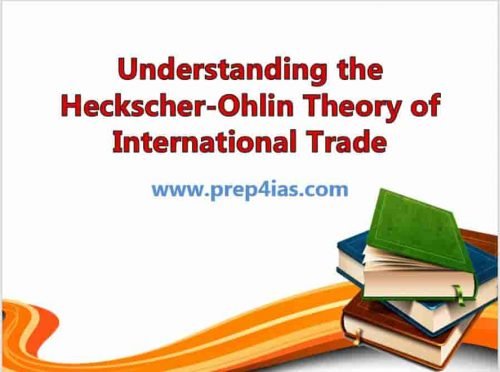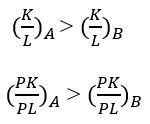In this article, we shall discuss the Heckscher-Ohlin theory of International Trade. This theory is very important when it comes to international trade. We shall discuss how this theory can be applied to find the equilibrium of trade and how countries can benefit from imports and exports. The criticism of the theory will also be discussed.
What is Heckscher-Ohlin Theory
The Heckscher-Ohlin theory explains the simple dynamic of international trade, it suggests that countries tend to export the goods and services which they can produce efficiently. The model is used for evaluating trade and determines the right equilibrium for trade that should exist between two countries that have different fields in which they specialize and their respective natural resources.
Countries tend to have different resources and assets and hence it is not possible for any country to produce everything on its own. The theory explains that trade must be made against the products that the country can efficiently and effectively produce at a lower cost with the available factors of production. It also states that whatever goods and services a country cannot produce efficiently, it should import from other countries.

Understanding the Heckscher-Ohlin Theory of International Trade
Also Read: Understanding the concepts of Laffer and Philips Curve
The theory has been retrieved from a very famous paper written by Eli Heckscher in the year 1919 while he was working at the Stockholm school of economics, later his student Bertil Ohlin added to his theory in the year 1933. The theory presents a mathematical model to determine how a country should trade while maximizing its profits considering the available resources and costs. The model does not only consider tradeable goods but also considers factors of production such as labor.
The cost of labour differs from country to country, in some parts of the world the minimum wage rate is higher than in the rest of the world. for example, in western and developed countries labour wage rate is higher than in Asian or third world countries. Hence it is important that countries where labor is cheap produce labor intensive products. Whereas the countries which have abundant capital should produce capital intensive products.
Although the model states a very good explanation for how international trade should be conducted there are still many economists who find it hard to find relevant evidence to prove the model. Several different models have been used to understand the reason behind all the developed countries preferring to trade with one another rather than trading with developing countries.
The Linder Hypothesis is a very important theory that explains this phenomenon. According to Heckscher, international trade is not much different than regional trade, rather it is a special case of inter-regional trade. The only main factor that serves as the major difference between regional and international trade is the exchange rate. Most countries use the dollar as the standard currency for trade. Hence, foreign exchange rates are a major deciding factor for imports and exports.
The Heckscher-Ohlin Trade Theorem
Ohlin stated in his theory that different parts of the world are all regions that have been separated by borders, customs, languages, and traditions. But these differences do not particularly impact trade. According to another famous economist, Ricardo, international trade is based majorly on the comparative costs of the products and the factor of production.
Ohlin explained that there are two major reasons behind the difference in comparative costs. First, different parts of the world have different resources and different factor endowments. Second, the production of different goods requires different proportions of factors of production.
Suppose K (availability or supply of capital), L (availability or supply of labour), PK stands for price for capital, and PL is the price for labor respectively. Further, let’s assume there are only two countries A and B. Country A has more capital than labour and country B is rich in labour but has less capital. Considering this case, we can say that capital intensive goods will be cheaper to produce in country A and labor-intensive goods will be cheaper to produce in country B.
 Thus, the difference in the factors of production creates a difference in comparative costs between the two trading countries. If the resources and factors of production in both countries are the same and both countries can efficiently produce similar products, this means that there will be no difference in comparative costs. Under such circumstances, the trade will not prove to be beneficial for the countries.
Thus, the difference in the factors of production creates a difference in comparative costs between the two trading countries. If the resources and factors of production in both countries are the same and both countries can efficiently produce similar products, this means that there will be no difference in comparative costs. Under such circumstances, the trade will not prove to be beneficial for the countries.
Example of Heckscher-Ohlin Theory
There are many real-life examples to prove the trade theory presented by Heckscher-Ohlin. America is a developed country; it has a lot of natural resources as well as factor endowments. The country has abundant capital and resources. Hence, America produces capital-intensive goods such as machinery, cars, electronic equipment, computers, mobile phones etc. India on the other hand is labor intensive, there are a lot of workers in India due to its large population. The wage rate is quite low in the country which makes labour in the country very cheap.
Hence, the country produces labor-intensive goods. Due to the difference in products that both the countries produce it is highly beneficial for them to trade. America imports clothing, tools and spices from India and exports cars and electronics to them. It keeps the trade-in balance and both countries benefit from focusing on the production of goods and services that they can produce at a comparative cost.
Criticism of Heckscher-Ohlin Theory
The major criticism of Heckscher-Ohlin theory is that it assumes all the countries are same except for their differences in factor endowments and resources. This also implies that the aggregate demand for goods would be similar in both countries but that is not the case instead traditions, values and customs do impact the preferences of individuals. Hence, the countries that have more capital produce capital-intensive goods and the countries with more labour produce labor-intensive goods.
The model of Heckscher-Ohlin theory excludes one big possibility of unemployment, it assumes that all the labour in the economy is employed to produce goods. But, if the total labour is divided into categories of skilled and unskilled labour then this problem can be solved. America imports unskilled labor-intensive goods and exports skilled labor-intensive goods.
Conclusion
Heckscher-Ohlin theory is considered to be one of the most important theories that explain international trade. The theory suggests that if each country specializes in producing goods that they can produce at a comparative cost and starts exporting it then they can benefit from the trade. All countries should produce goods that they can produce effectively and efficiently. To conclude, trade is only beneficial if the countries involved focus on their resources and utilize them efficiently to produce goods.
